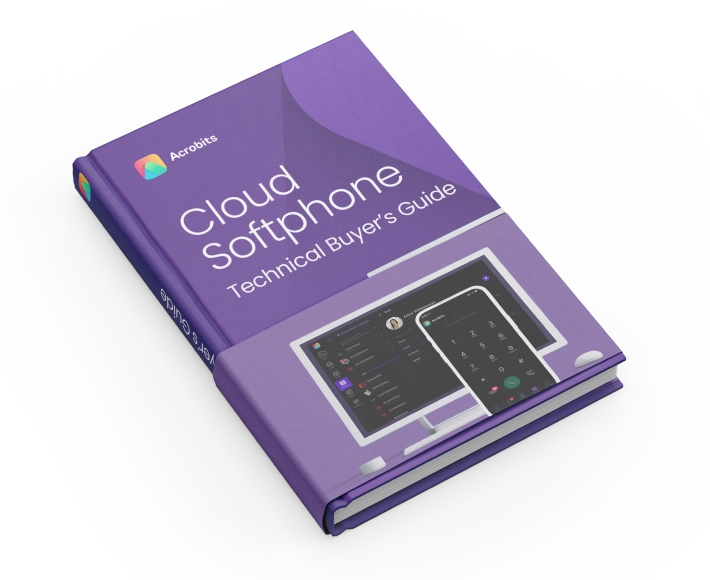
Build a white label softphone app
Create a custom white-label softphone with Cloud Softphone.
- No devs needed
- Native desktop apps
- 100+ premium features

In today’s rapidly evolving unified communications landscape, organizations and communication service providers face critical decisions about the underlying technologies powering their communication infrastructure.
Whether you’re developing a white label VoIP app for your business or evaluating enterprise communication solutions, choosing native SIP applications and browser-based WebRTC solutions has significant implications for performance, reliability, user experience, and long-term business success.
Many companies find this decision challenging, considering factors like compatibility across operating systems, development talent requirements, specific functionality integration, and keeping projects on schedule and budget.
The debate between native SIP applications with proprietary code and browser-based WebRTC solutions continues to evolve, but fundamental architectural differences create persistent advantages and disadvantages that every decision-maker must carefully consider.
While both approaches continue to advance and the performance gap has narrowed considerably, there’s no single “wrong” answer to this dilemma. Instead, success lies in understanding the strengths of each method and recognizing that both options can coexist in what’s increasingly becoming a hybrid future.
Native SIP Apps are downloadable programs retrieved through online marketplaces like Apple’s App Store and Google’s Play Store, or deployed directly in enterprise environments. These applications include all the popular communication tools we use daily, from business softphones to messaging platforms.
Native apps use platform-specific languages like Objective-C for iOS and Java for Android during development, meaning businesses must develop them individually for each operating system, requiring additional resources to port them across platforms.
Web Apps operate through standard web browsers and are accessed via URLs rather than downloads. In the communications space, these are typically WebRTC-based solutions that leverage browser APIs to deliver voice, video, and messaging capabilities.
Web apps share the same codebase regardless of whether they run on Android, iOS, Chrome, or Firefox, making cross-platform deployment significantly simpler.
The fundamental architectural difference lies in how these applications access device resources and integrate with the underlying operating system – a distinction that becomes particularly important for professional communication applications.
Related read:
Who Needs to Switch to Softphones? Unlocking Agile Business Communications
Stronger Performance: Native apps have direct access to your device’s processing power, resulting in much better efficiency and smoother, hitch-free usage. Business professionals consider developing natively to be a smart investment because a great app experience means higher conversion rates and consumer loyalty.
This performance advantage becomes critical in communication applications where audio quality and real-time responsiveness directly impact business outcomes.
Natural, Intuitive Usability: Native apps feel noticeably more “natural” than web apps. Developers have the flexibility to tailor the app to each operating system’s design language and standards.
You also get hardware-level functionality like vibration (haptics), touch gestures, and push notifications. White label VoIP softphone apps, which depend heavily on features like these, require native development for optimal user experience.
Professional Peripheral Integration: One of the most significant advantages for business communications is comprehensive hardware integration.
Professional headsets from manufacturers like Jabra, Poly/Plantronics, EPOS/Sennheiser, and Yealink represent significant enterprise investments, and their sophisticated features are accessible only through proprietary SDKs available for native implementations.
This includes:
Enterprise Deployment Flexibility: Native applications can be deployed through enterprise channels outside of public app stores using enterprise certificates, providing IT departments with greater control over distribution, updates, and security compliance.
Support from App Markets: With millions of users browsing app stores every day, interested clients have a higher chance of finding your native app than your web app. Many app markets also provide quality control, security, and compatibility guarantees to their users, making your company more trustworthy from the start.
Costly Development: One area where native apps struggle is compatibility. Porting a native app to another operating system requires a hefty investment of time and money, as multiple versions of the app are required. The result is higher costs, developmental constraints, and more time before launching to market.
Accessibility Issues: Users on budget devices may not have enough storage space to install apps or might run on an older version of the operating system incompatible with your app. Web apps become the only option for these types of clients.
Less Versatility for Occasional Use: While websites are virtually mandatory for any modern company, not every business interaction needs a dedicated app. For services used infrequently, web interfaces may be more appropriate than requiring app downloads.

Cost-Effective Development: Since the providers behind your current company website likely offer mobile templates, there are fewer upfront costs to create a web app as opposed to a fully-fledged native app. Porting a web app to multiple mobile operating systems and browsers is much easier as well.
Ease of Maintenance: Web apps all share the same codebase, regardless of whether they run on Android, iOS, Chrome, or Firefox. Users won’t have to handle updates either since the newest version of the site always loads first, simplifying IT maintenance and ensuring all users have access to the latest features.
Improved Accessibility: Web apps are the way to go if you want to target as many mobile users as possible. Without the need to download an app, web apps save on a device’s storage space and provide immediate access without installation barriers.
More Monetization Options: Some app stores and device manufacturers restrict what you can do on a native app regarding advertising and monetization. You have much more freedom when it comes to online advertising and revenue generation with custom tabs with web views.
Convergence of Performance: The performance gap between native and web applications has undeniably narrowed in recent years. Modern browsers have made remarkable strides in hardware access through sophisticated APIs, while JavaScript engines have dramatically improved execution speed. Well-optimized WebRTC applications can now achieve near-native performance for standard communication scenarios.
Cumbersome Usage: Users have to enter a URL or search term to reach your app. Web apps are also slower and less responsive than native apps, thanks to longer loading times and site layouts that may not be compatible with all phone sizes and screen resolutions. This extra effort results in frustration that can turn away potential clients.
Shackled Features: Web applications don’t enjoy the same degree of functionality and hardware integration as native ones. Complex touch gestures, push notifications, and haptic feedback (vibration) are often not available, making non-native development unsuitable for professional VoIP applications requiring advanced peripheral integration.
Limited Publicity: Because your app won’t be on a popular app marketplace, it can be difficult to gain users and publicity for your business. More and more people are discovering applications through app stores rather than web searches.
Reliance on Internet Connectivity: While most native apps can run without an Internet connection, at least partially, web apps entirely depend on a stable connection. Any loss of reception can halt a user’s experience abruptly.
A critical limitation of web-based UC solutions is their complete dependence on the browser application itself. This creates an inherent vulnerability in the communication system that can have serious business implications:
Inadvertent Communication Disruption: Users accustomed to managing multiple browser tabs can easily close their communication interface inadvertently, immediately terminating all calling capabilities. This common scenario leads to missed calls and fragmented conversations.
Resource Competition: Browsers share resources across all active tabs (especially Chrome), meaning resource-intensive websites or applications can impact communication quality unpredictably.
Update Disruptions: Browser updates or crashes affect the entire communication system, creating potential downtime that dedicated applications avoid.
Business Continuity Risk: In time-sensitive business scenarios such as customer service, secure communications, or healthcare communications, this dependency represents not just an inconvenience but a critical business continuity issue.
Despite WebRTC’s open-source appeal, it introduces significant constraints on development roadmaps and innovation cycles:
Chromium Ecosystem Dependency: WebRTC app developers remain largely dependent on the Chromium project’s implementation and Google’s priorities, creating unpredictable development timelines for new features or optimizations.
Multi-Layer Update Requirements: Implementing new capabilities requires coordinated updates across the WebRTC standard, browser implementations, and application code, creating inevitable delays compared to native development paths.
Reactive Innovation Model: When operating systems introduce new features or capabilities—such as enhanced audio processing, battery optimization, or security features—native SIP app developers can integrate them immediately, while WebRTC solutions must wait for standardization and browser implementation, creating a persistent innovation gap.
For organizations with significant investments in communication hardware and mission-critical communication requirements, web-based communication solutions create tangible disadvantages that extend beyond theoretical performance considerations to directly impact daily operations.
Professional-grade communication hardware has become standard in enterprise environments, representing significant investments specifically made to enhance communication quality and efficiency. However, these devices offer sophisticated features through proprietary SDKs that remain exclusively available for native implementations.

Web-based UC solutions cannot access these capabilities due to fundamental browser security limitations. This creates a disconnected experience where expensive hardware features remain inaccessible, undermining the return on investment for peripheral devices and reducing user productivity.
Additionally, the vulnerabilities created by browser dependency represent unacceptable risks for mission-critical business operations where communication reliability cannot be compromised by routine browsing activities.
There’s no need to choose exclusively between a native SIP app or a webRTC app. A successful development strategy should incorporate both to reduce the resources needed during development while maximizing functionality and user experience.
Native SIP apps are ideal for providing enhanced performance and seamless experiences, but coding complex functionalities can strain your budget. These costs can quickly balloon out of control when you have to create different versions of your app for each operating system.
WebRTC apps can make a huge difference by allowing you to easily integrate advanced functions across multiple platforms using standard web browsers. They are an excellent way for companies to implement specific features that are important to products and services without drastically increasing development costs.
Hybrid apps merge the best of both formats to create streamlined applications capable of delivering powerful user experiences while maintaining cost-effective development and maintenance.
While web applications face limitations as comprehensive UC solutions, they serve as excellent complementary tools in specific scenarios:
Administrative Portals: Web interfaces excel for configuration management, reporting, and analytics dashboards where real-time communication is not required.
Occasional Users: For stakeholders who only occasionally need communication features, web interfaces provide convenient access without installation requirements.
Simple Collaboration: Basic messaging, file sharing, and asynchronous collaboration work well in web environments where advanced peripheral integration isn’t essential.
Related read:
7 Use Cases for Acrobits Custom Tab with Web View
However, it’s important to recognize that web applications alone cannot deliver the complete unified communications experience that modern enterprises require. The comprehensive feature set, reliability, and integration capabilities necessary for mission-critical business communications currently demand native application components.
Cloud Softphone demonstrates how a comprehensive unified communications experience can be achieved by combining native performance with web flexibility. This approach doesn’t just address theoretical concerns—it translates to tangible benefits for IT teams, end-users, and business operations.
As an Application Platform as a Service (APaaS), Cloud Softphone makes it easy to create hybrid apps that leverage all the advantages of native SIP and web applications while avoiding their respective limitations.
| Feature | Cloud Softphone | Web-Only Solutions | Why It Matters |
| Native Implementation | ✓ Fully native, serverless architecture with no WebRTC dependencies | ✗ Browser-dependent with WebRTC limitations | Ensures consistent performance regardless of browser updates or availability |
| Enterprise Deployment | ✓ Mass deployment outside app stores with enterprise certificates | ✗ Limited to browser deployment | Simplifies IT rollouts and updates while maintaining security compliance |
| Automatic Updates | ✓ Built-in framework for seamless background updates | ✗ Requires browser refresh or reinstallation | Minimizes disruption and ensures security patches are applied promptly |
| Headset Integration | ✓ Full support for Jabra, Sennheiser, Poly, Yealink and other professional headsets | ✗ Limited to basic browser audio APIs | Allows teams to maximize their hardware investment with advanced features |
| PUSH Notifications | ✓ Native push notification support | ✗ Requires active browser and continuous polling | Extends battery life and ensures users never miss important communications |
| Embedded Web Content | ✓ Supports authenticated web browser tabs for custom content | ✓ Basic web content display | Combines the best of both worlds—native performance with web flexibility |
| SIP Protocol Support | ✓ Complete SIP 2.0 implementation | ⚠️ Limited SIP support via WebRTC | Ensures compatibility with enterprise PBX systems and advanced telephony features |
| Messaging Capabilities | ✓ Turn-key multi-party messaging with persistent history | ⚠️ Basic messaging capabilities | Facilitates seamless team collaboration without additional tools |
| Video Conferencing | ✓ Integrated high-quality video conferencing | ⚠️ Quality dependent on browser capabilities | Delivers reliable visual communication for remote teams |
Less Coding: The platform makes it easier to port to other operating systems. There’s no need to build two separate apps for Android and Apple. Working with one codebase makes it simple to update and add new features to your app as it grows.
Spend Less on Development: The goal of licensing a white label VoIP app is to save money. The hybrid approach allows you to create a solid foundation from which you can integrate other essential functions that your app may need.
Scale on Your Terms: Cloud Softphone scales with your company as you grow. You receive constant updates and can enhance your existing app over time through comprehensive APIs.
Access Device-Specific Features: You never have to worry about alienating loyal iOS and Android supporters. Your white label VoIP app can access features that are unique to specific devices and their SDKs.
Behind these technical specifications are real human experiences that directly impact productivity and satisfaction:
For the IT Manager: “With Cloud Softphone, I finally stopped receiving daily support tickets about headset malfunctions and missed calls. My team can focus on strategic initiatives instead of troubleshooting communication issues.”
For the Knowledge Worker: “I can seamlessly move from my desk to a meeting room without interrupting my call—my headset controls work everywhere. Plus, I never miss important calls because they’re not dependent on having a browser tab open.”
For the Customer Service Team: “Our response times have improved dramatically since switching to Cloud Softphone. The reliable push notifications and headset integration mean we can respond to customers faster, even when we’re away from our screens.”
For the Remote Team Member: “The video conferencing quality is consistently better than our previous solution, and I don’t have to worry about my browser crashing mid-presentation. It’s one less thing to worry about when working remotely.”
Another critical dimension in the native vs web application debate concerns security and compliance requirements that are paramount for enterprise communications. Native applications offer several distinct advantages in this domain:
Enhanced Data Protection: Native applications can implement more sophisticated encryption and security mechanisms without the limitations imposed by browser sandboxing, providing better protection for sensitive business communications.
Compliance Certification: Many regulated industries require communications systems to meet specific security standards. Native applications typically have more comprehensive certification options available across healthcare, financial services, and government sectors.
Authentication Integration: Native applications can more seamlessly integrate with enterprise authentication systems and biometric security features, providing stronger identity verification for sensitive communications.
These security considerations further underscore why many enterprises with stringent compliance requirements continue to favor native or hybrid communication solutions over purely web-based alternatives.
When evaluating the total cost of ownership for communication applications, organizations must consider both upfront development costs and long-term operational value.
Web Apps: Lower initial investment due to single codebase development and existing web development talent availability. Faster time to market for basic functionality.
Native Apps: Higher initial costs due to platform-specific development requirements and the need for specialized mobile development expertise. Longer development cycles for cross-platform deployment.
Hybrid Apps: Moderate initial investment that balances development efficiency with comprehensive functionality. Leverages existing web technologies while providing native performance where needed.
You can explore a full, no-nonsense breakdown of buying vs building a softphone here.

Weigh costs and options: DIY vs. white labeling.
Peripheral Integration ROI: Organizations with significant hardware investments see measurable returns through improved employee productivity and maximized equipment utilization with native integration capabilities.
Reliability and Support Costs: Native and hybrid solutions typically require fewer support interventions due to their independence from browser-related issues, reducing ongoing IT overhead.
Scalability and Innovation: Native capabilities enable faster adoption of new platform features and communication technologies, providing competitive advantages and future-proofing investments.
User Productivity Impact: The seamless experience provided by properly integrated communication tools translates to measurable productivity gains that often justify higher initial development costs.
Organizations should assess their unified communications technology based not only on current feature parity but on the fundamental architectural capabilities that will determine long-term performance, reliability, and innovation potential.
As unified communications continue to evolve as a critical business function, the evidence increasingly points toward hybrid approaches as the optimal solution for most organizations.
Pure web-based solutions offer deployment simplicity and adequate performance for basic scenarios but introduce significant limitations for organizations with advanced peripheral integration needs, reliability requirements, or innovation priorities.
Native applications maintain fundamental advantages for mission-critical communication systems where reliability, peripheral integration, security compliance, and feature advancement are essential requirements. However, the development and maintenance costs can be prohibitive for organizations with diverse platform requirements.
Hybrid approaches represent an emerging solution category that delivers the best of both worlds—combining the reliability and integration capabilities of native technologies with the flexibility and customization benefits of web components. For many enterprises, the hybrid approach offers the optimal balance of capability, reliability, and flexibility in today’s complex communications landscape.
The future of business communications lies not in choosing between native and web technologies, but in intelligently combining them to create solutions that serve real business needs while maximizing return on investment. Organizations that embrace this hybrid future will be best positioned to deliver exceptional communication experiences while maintaining the agility to adapt to evolving business requirements.
Whether you’re developing a white label VoIP application or evaluating enterprise communication solutions, the key is understanding that both native and web technologies have roles to play in a comprehensive communication strategy. The question isn’t which technology to choose, but how to combine them most effectively to serve your specific business objectives and user needs.

Every telecom provider knows the appeal of a quick fix. Deploy a generic softphone app, get your users online, and move on. But as the market surges toward $400 billion by 2034, the cracks in this approach are becoming impossible to ignore. Scaling, branding, and innovation all hit a ceiling fast. The hidden cost of […]

Picture this: your softphone app aces every backend test, but users drop off after the first call. Why? Technical reliability alone won’t win the adoption game, intuitive onboarding, seamless UI, and robust call quality all matter equally. Testing and launching a softphone app is a two-front battle, and neglecting either side puts your brand and […]

Not every VoIP user needs the same thing. Some just want a rock-solid app to connect their SIP line. Others need to launch a white-label softphone under their own brand. Acrobits offers two very different tools to cover both ends of that spectrum: Groundwire and Cloud Softphone. Feature Groundwire Cloud Softphone Pricing $9.99 one-time purchase […]

For many small and medium-sized businesses, the traditional PBX (Private Branch Exchange) phone system has long been the backbone of daily communication. As remote work becomes the norm and digital transformation accelerates, these hardware-bound systems are increasingly feeling like a bottleneck: they are costly to maintain, inflexible, and ill-suited for modern workflows. If you’re an […]